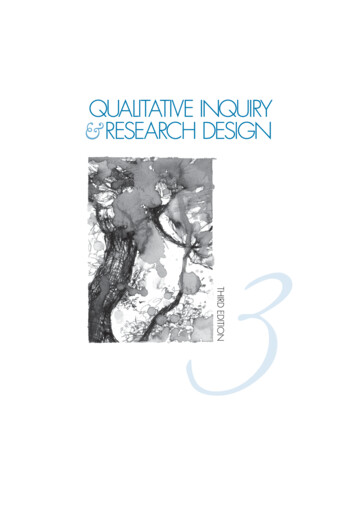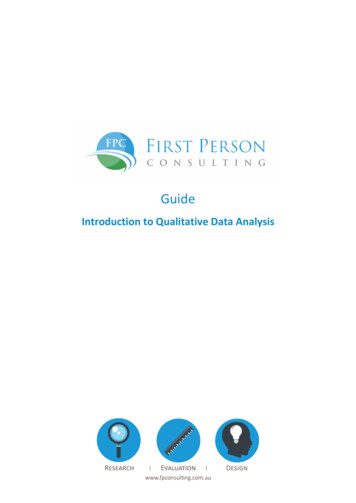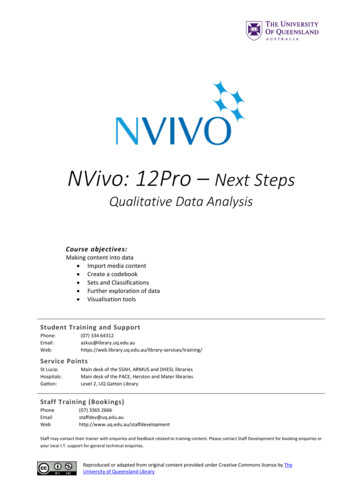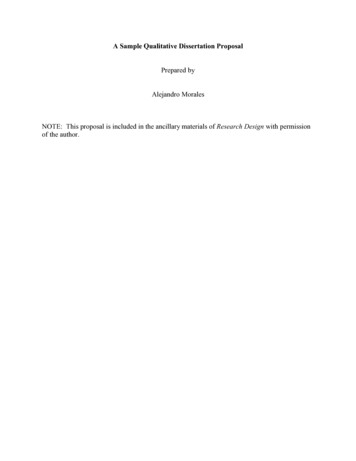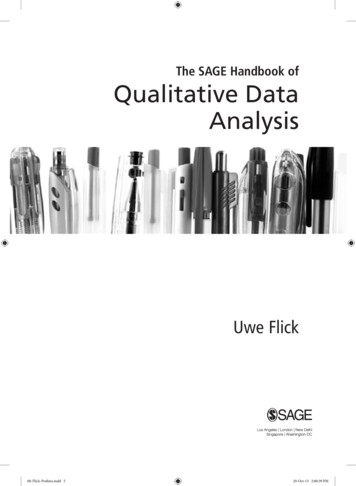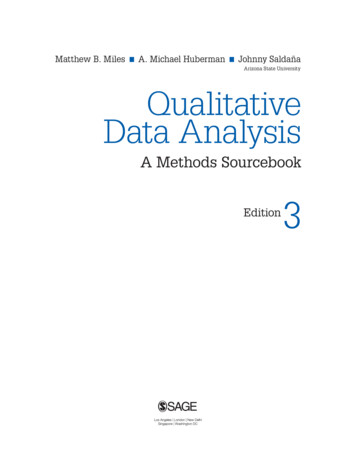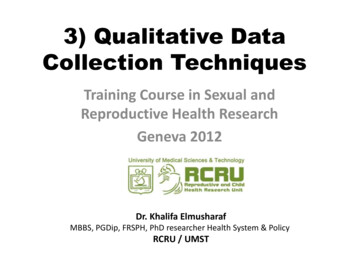
Transcription
3) Qualitative DataCollection TechniquesTraining Course in Sexual andReproductive Health ResearchGeneva 2012Dr. Khalifa ElmusharafMBBS, PGDip, FRSPH, PhD researcher Health System & PolicyRCRU / UMST
Objective of PresentationBy the end of this presentation you should beable to: Describe different types of data collection techniques Demonstrate dimensions , type of observations and how to prepare andconduct observation Understand the practical communication skills for interviews to ask goodquestions , probe and follow up questions Able to prepare for interview Understand the characteristics and uses of focus group discussions Conduct focus group discussions
Overview ofData Collection Techniques Data collection techniques allow us tosystematically collect information about ourobjects of study (people, objects, phenomena)and about the settings in which they occur. In the collection of data we have to besystematic. If data are collected haphazardly, itwill be difficult to answer our researchquestions in a conclusive way.
Data Collection Techniques1. Document Review2. Observation3. Interview (face-to-face)4. Focus Group Discussion
Document Review
1. Document Review A qualitative research project may requirereview of documents such as:– Course syllabi– Faculty journals– Meeting minutes– Strategic plans– Newspapers
1. Document Review Depending on the research question, theresearcher might utilize:– Rating scale– Checklist– Content analysis– Matrix analysis
Observation
2. Observation OBSERVATION is a technique that involves systematicallyselecting, watching and recording behaviour andcharacteristics of living beings, objects or phenomena. Without training, our observations will heavily reflect ourpersonal choices of what to focus on and what toremember. You need to heighten your sensitivity to details that youwould normally ignore and at the same time to be able tofocus on phenomena of true interest to your study.
Type of ObservationObservation of human behaviour Participant observation: The observer takespart in the situation he or she observes– Example: a doctor hospitalised with a broken hip,who now observes hospital procedures ‘fromwithin’ Non-participant observation: The observerwatches the situation, openly or concealed,but does not participate
Type of Observation Open– (e.g., ‘shadowing’ a health worker with his/herpermission during routine activities) Concealed– (e.g., ‘mystery clients’ trying to obtain antibioticswithout medical prescription) Observations of objects– For example, the presence or absence of a latrine andits state of cleanliness
Type of Observation1. General observation may be used as the startingpoint in to be familiar with the setting and the newcontext.2. More focus observation may be used to evaluatewhether people really do what they say they do.3. Access the unspoken knowledge of subject, that is,the subconscious knowledge that they would not beable to verbalise in an interview setting.4. Compare a phenomena and its specific componentsin greater detail.
Dimensions of Observation1.Space (physical places)2.Actors (people involved)3.Activities (the set of related acts people do)4.Object (the physical things that are present)5.Time (the sequencing that takes place over time)6.Goal (the things people are trying to accomplish)7.Feeling (the emotions felt and expressed)(Spradlet 1979)
Preparing for Observation1. Determine the purpose of the observation activity asrelated to the overall research objectives2. Determine the population(s) to be observed3. Consider the accessibility of the population(s) and thevenues in which you would like to observe them4. Investigate possible sites for participant observation
Preparing for Observation5. Select the site(s), time(s) of day, and date(s), andanticipate how long you will collect participantobservation data on each occasion6. Decide how field staff will divide up or pair off tocover all sites most effectively7. Consider how you will present yourself, both interms of appearance and how you will explainyour purpose to others if necessary
Preparing for Observation8. Plan how and if you will take notes during theparticipant observation activity9. Remember to take your field notebook and apen
After Participant Observation10. Schedule time soon after participantobservation to expand your notes11. Type your notes into computer files usingthe standard format set for the study
INTER-VIEW
3. Interview An INTERVIEW is a data-collection (generation)technique that involves oral questioning ofrespondents. Answers to the questions posed during aninterview can be recorded by writing themdown or by tape-recording the responses, orby a combination of both.
High Degree of Flexibility When studying sensitive (teenage pregnancy and abortions) A list of topics may include:– How teenagers started sexual intercourse– The actions couples take in the event of unwanted pregnancies The investigator should have an additional list of topics ready when therespondent falls silent– e.g., when asked about abortion methods used– who made the decision and who paid
High Degree of Flexibility The sequence of topics should be determined bythe flow of discussion. It is often possible to come back to a topicdiscussed earlier in a later stage of the interview. The unstructured or loosely structured method ofasking questions can be used for interviewingindividuals as well as groups of key informants(FGD).
Low Degree of Flexibility Less flexible methods of interviewing areuseful when the researcher is relativelyknowledgeable about expected answers orwhen the number of respondents beinginterviewed is relatively large. Then questionnaires may be used with a fixedlist of questions in a standard sequence, whichhave mainly fixed or pre-categorised answers.
Practical Communication Skills forInterviews Good communication should lead to a sharedunderstanding Be aware of nonverbal communication (70%) Giving constructive feedback1.2.3.4.Comment on positive things firstBe constructiveBe specificDo no give direct or blaming criticism
Practical Communication Skills forInterviews Ask good questions– Start with what, how, who, when, please give an example of– Question starting with “Why” make people feel uncomfortable Don’t ask a biased and leading or direct questions The type of question asked must be adapted to thechanging level of trust between interviewer andinformant during the interview
Probing PROBING is a good questioning skillExamples Does the child have fever? (Closed question)– Probes How high is the fever?– Since when has he had the fever? Have you given the child medicine?– Probes What kinds of medicines have you given?– How much? For how long?
Type of Question Hypothetical question:– Suppose you had more money, how would you spend that? Provocative question:– Some say that HIV is the punishment of God, what do you think aboutthat? Ideal question:– Please describe to me what a good delivery would be like. Interpretative question:– You said earlier that you go to healers for diarrhoea, how this relatedideas about hot-cold?
Type of Question Experience question:– Could you tell me about your experience of caring forpatients with cancer? Feeling question:– How did you feel when the first patient in your caredied? Knowledge question:– What services are available for this group of patients?
Type of Question Grand-tour question:– Can you describe a typical day in the community? (toa community midwife) Mini-tour question:– Can you describe what goes on when a women diegiving birth? Example question:– Can you give me an example of a difficult delivery?
Type of QuestionType of QuestionPurposeOpening questionsTo identify the characteristics that the participants havein common. Participants should be given an opportunityto introduce themselves.Introductory questionsTo introduce the general topic of the discussion, and tostimulate the conversation and improve interaction in thegroup.Transition questionsTo move the participants into the focus of the discussion.Key questionsConcern about the focus of the interview.Ending questionsGive the participants an opportunity to make finalstatement.Final questionsAsk the participants to add things they think have notbeen considered during the discussion.
Prepare for the Interview Recruit participants according to the recruitmentstrategy outlined in the work plan. Set up recording equipment and the physicalspace where interviews will take place. Become knowledgeable about the research topic,including anticipating and being prepared toanswer any questions participants may haveabout it.
Prepare for the Interview Be reliable. To get participants to take theinterview seriously, you need to demonstrateyour own commitment. Arrive on time,equipped with the recording equipment,interview guide, and notebooks. Be bothmentally and psychologically prepared toconduct the interview. Keep all promises youmake to participants.
Prepare for the Interview Obtain informed consent from each participantbefore the interview. Address all questions or topics listed in theinterview guide. Ask follow-up questions (some of which may bescripted in the interview guide) in order to elicitparticipants’ complete knowledge and experiencerelated to the research topic.
Prepare for the Interview Probe participants for elaboration of theirresponses, with the aim of learning all theycan share about the research topic.
Document the Interview Record the interview using an audio (and sometimes video)recorder Take backup notes Observe and document participants’ behaviors andcontextual aspects of the interview as part of your fieldnotes Expand your notes as soon as possible after each interview,preferably within 24 hours, while your memory is still fresh
4. Focus Group Discussion
InterviewsFocus GroupsAppropriate forStrength of Method Eliciting individualexperiences, opinions, feelings Elicits in-depth responses, withdifferences and contradictions Addressing sensitive topics Gets at interpretive perspective, i.e.,the connections and relationships aperson sees between particularevents, phenomena, and beliefs Identifying group norms Elicits information on a range ofnorms and opinions in a short time Eliciting opinions about groupnorms Discovering variety within apopulation Group dynamic stimulatesconversation, reactions
Characteristics and Uses of FGD A FGD is a qualitative method. Its purpose is to obtain in-depth information onconcepts, perceptions and ideas of a group. A FGD aims to be more than a question-answerinteraction. The idea is that group members discuss thetopic among themselves, with guidance fromthe facilitator.
FGD Techniques Can be Used To1- Focus research and develop relevant research hypotheses byexploring in greater depth the problem to be investigated and itspossible causes.example: A district health officer had noticed that there were an unusuallylarge number of cases of malnutrition of children under 5 reportedfrom one area in her district. Because she had little idea of why there might be moremalnutrition in that area she decided to organise 3 FGD (one withleaders, one with mothers and one with health staff from thearea). She hoped to identify potential causes of the problem through theFGDs and then develop a more intensive study, if necessary.
FGD Techniques Can be Used To2- Formulate appropriate questions for more structured, largerscale surveys.example: In planning a study of the incidence of childhood diarrhoea andfeeding practices, a FGD showed that in the community understudy, children below the age of 1 year were not perceived ashaving ‘bouts of diarrhoea’ but merely ‘having loose stools’ thatwere associated with milestones such as sitting up, crawling, andteething. In the questionnaire that was developed after the FGD theconcept ‘diarrhoea’ was therefore carefully described, using thecommunity’s notions and terms.
FGD Techniques Can be Used To3- Help understand and solve unexpected problems ininterventions.example: In District X, the recent national (polio) immunisation days(NID) showed widely different coverage’s per village (50-90%)and in a number of villages a marked decrease in coveragewas observed compared to last year. Eight FGD were held with mothers, two in town, three inrural villages with a marked decrease in NID coverage andthree in villages with a high coverage throughout.
FGD Techniques Can be Used ToExample (continue) It appeared that overall, the concept NID had raised confusion.Most people believed that this mass campaign strengthened thechildren’s immunity against any (childhood) disease, includingmalaria and Respiratory Tract Infections. In the villages with a low NID coverage there had been a highincidence of malaria in children immediately after the previous NIDcampaign and several children died. Mothers therefore believedthat the NID campaign was useless.
FGD Techniques Can be Used To4- Develop appropriate messages for health educationprogrammes and later evaluate the messages for clarity.example: A rural health clinic wanted to develop a health educationprogramme focused on weaning problems most oftenencountered by mothers in the surrounding villages and what todo about them. The FGD could be used for exploring relevant local concepts aswell as for testing drafts when developing the messages. The messages should be developed and tested in different socioeconomic groups of mothers, as weaning practices may differwith income, means of subsistence and education of themothers. Also ethnic differences may have to be taken intoaccount.
FGD Techniques Can be Used To5- Explore controversial topicsexample: Sexual behaviour is a controversial topic in the sense that malesand females judge sexual relations and sexuality often fromvery different perspectives. Sexual education has to take thisdifference into account. Through FGDs, first with females, then with males, and thenwith a mixed group to confront both sexes with the differentoutcomes of the separate discussions (listed on flip charts) itbecomes easier to bring these differences in the open.Especially for teenagers, who may have many stereotypesabout the other sex or be reluctant to discuss the topic openly(particularly girls), such a ‘multi-stage’ approach is useful.
Strengths and Limitations of FGD A well chosen group, in terms of composition andnumber, FGDs can be a powerful research toolwhich provides valuable spontaneous informationin a short period of time and at relatively low cost. FGD should not be used for quantitative purposes,such as the testing of hypotheses or thegeneralisation of findings for larger areas, whichwould require more elaborate surveys.
Strengths and Limitations of FGD Depending on the topic, it may be risky to useFGDs as a single tool. In group discussions, people tend to centre theiropinions on the most common ones, on ‘socialnorms’. In reality, opinions and behaviour may be morediverse. Therefore it is advisable to combine FGDswith at least some key informant and in-depthinterviews.
Strengths and Limitations of FGD In case of very sensitive topics, such as sexualbehaviour or coping with HIV/AIDS, FGDs mayalso have their limitations, as group membersmay hesitate to air their feelings andexperiences freely. One possible remedy is the selection ofparticipants who do not know each other (e.g.,selection of children from different schools inFGDs about adolescent sexual behaviour),while assuring absolute confidentiality.
How To Conduct a FGD
Determine the Purpose A FGD can be regarded as a mini-study. It therefore requires one or two clearobjectives. These objectives will guide the research teamin the formulation of discussion questions.
Situation Analysis Any FGD requires good knowledge of localconditions. There are always differences between communitymembers, for example in education, political power,gender, economic status and ethnic group. These differences will be reflected in theirperceptions of the problems they suffer from andpossible solutions. A researcher must be aware of these differences.
Situation Analysis The first task of the researchers will be to explorethe area and identify possible target groups. Interviews with some key informants and arudimentary situation analysis are thenindispensable. The situation analysis should preferably becarried out in a participatory way, withrepresentatives of the study population on whichthe FGD focuses.
Points to be considered whenpreparing the FGD
A. Recruitment of Participants Participants should be roughly of the samesocio-economic group or have a similarbackground in relation to the issue underinvestigation. The age and sexual composition of the groupshould facilitate free discussion.
B. Selection of Participants If you are an outsider, you may have to rely onyour key informants for the first selection ofparticipants in FGDs. Your key informants to whom you haveexplained thoroughly the purpose and theprocess of the FGD might each suggest someindividuals who could be invited to a focusgroup discussion.
B. Selection of Participants The key informants may select persons similar tothemselves so that you do not get an adequatevariety of views in your discussion group. So in your explanations be sure to emphasise thatyou want a group of people that can express a rangeof views, to be able to have a proper discussion. Participants in a first FGD may assist to find relevantparticipants for other groups. Another way is to select individuals in a systematicway, to try and ensure a range of views. You might,ask every third or fourth person you find. Thismethod might be more suitable in urban areas.
C. Physical Arrangements Communication and interaction during the FGD shouldbe encouraged in every way possible. Arrange the chairs in a circle. Make sure that there willbe no disturbances, sufficient quietness, adequatelighting, etc. Try to hold the FGD in a neutral setting whichencourages participants to freely express their views. A health centre, for example, is not a good place todiscuss traditional medical beliefs or preferences forother types of treatment.
D. Preparation of a Discussion Guide There should be a written list of topics to becovered. It can be formulated as a series of open-endedquestions. Guides for different groups gathered to discussthe same subject may vary slightly, depending ontheir knowledge or attitudes and how the subjectshould first be explored with them.
Conducting the FGD Session
Functions of the Facilitator1.2.3.4.5.6.7.Introduce the sessionEncourage discussion and involvementDeal correctly with sensitive issuesObserve non-verbal communicationAvoid being placed in the role of expertControl the rhythm of the meetingTake time at the end of the meeting to summarise,check for agreement and thank the participants8. Summarise the main issues brought up9. Listen for additional comments and spontaneousdiscussions after the meeting has been closed
Functions of the Recorder The recorder should keep a record of thecontent of the discussion as well as emotionalreactions and important aspects of groupinteraction. Assessment of the emotional tone of themeeting and the group process will enableyou to judge the validity of the informationcollected during the FGD.
Items to be Recorded Include Date, time, place Names and characteristics of participants General description of the group dynamics (level ofparticipation, presence of a dominant participant, level ofinterest) Opinions of participants, recorded as much as possible intheir own words Emotional aspects Vocabulary used – (to use it in developing questionnaires orhealth education materials) Spontaneous relevant discussions during breaks or after themeeting has been closed
Number of Sessions It depends upon project needs, resources, andwhether new information is still coming from thesessions (Saturation) One should plan to conduct at least two FGDs foreach sub-group (for example, two for males andtwo for females) Otherwise you have no way of assessing whetherthe information you get from the first FGD isrepresentative for that group
Duration of Sessions A focus group session typically lasts up to an hour anda half. Generally the first session with a particular type ofgroup is longer than the following ones because all ofthe information is new. Thereafter, if it becomes clear that all the groups havea similar opinion on particular topics, the facilitatormay be able to move the discussion along more quicklyto other topics which still elicit new points of view.
End
–Content analysis –Matrix analysis . Observation . 2. Observation OBSERVATION is a technique that involves systematically selecting, watching and recording behaviour and ch


